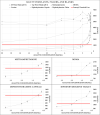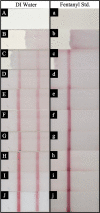High concentrations of illicit stimulants and cutting agents cause false positives on fentanyl test strips - PubMed (original) (raw)
High concentrations of illicit stimulants and cutting agents cause false positives on fentanyl test strips
Tracy-Lynn E Lockwood et al. Harm Reduct J. 2021.
Abstract
Background: The opioid epidemic has caused an increase in overdose deaths which can be attributed to fentanyl combined with various illicit substances. Drug checking programs have been started by many harm reduction groups to provide tools for users to determine the composition of their street drugs. Immunoassay fentanyl test strips (FTS) allow users to test drugs for fentanyl by either filling a baggie or cooker with water to dissolve the sample and test. The antibody used in FTS is very selective for fentanyl at high dilutions, a characteristic of the traditional use of urine testing. These street sample preparation methods can lead to mg/mL concentrations of several potential interferents. We tested whether these concentrated samples could cause false positive results on a FTS.
Methods: 20 ng/mL Rapid Response FTS were obtained from BTNX Inc. and tested against 4 different pharmaceuticals (diphenhydramine, alprazolam, gabapentin, and naloxone buprenorphine) and 3 illicit stimulants [cocaine HCl, methamphetamine, and 3,4-methylenedioxymethamphetamine (MDMA)] in concentrations from 20 to 0.2 mg/mL. The FTS testing pad is divided into 2 sections: the control area and the test area. Control and test area signal intensities were quantified by ImageJ from photographs of the test strips and compared to a threshold set by fentanyl at the FTS limit of detection.
Results: False positive results indicating the presence of fentanyl were obtained from samples of methamphetamine, MDMA, and diphenhydramine at concentrations at or above 1 mg/mL. Diphenhydramine is a common cutting agent in heroin. The street sample preparation protocols for FTS use suggested by many online resources would produce such concentrations of these materials. Street samples need to be diluted more significantly to avoid interference from potential cutting agents and stimulants.
Conclusions: Fentanyl test strips are commercially available, successful at detecting fentanyl to the specified limit of detection and can be a valuable tool for harm reduction efforts. Users should be aware that when drugs and adulterants are in high concentrations, FTS can give a false positive result.
Keywords: Drug testing; False positives; Fentanyl; Fentanyl test strip (FTS); Harm reduction; Opioid; Stimulant.
Conflict of interest statement
The authors declare that they have no competing interests.
Figures
Fig. 1
FTS with fentanyl standard: FTS ran with fentanyl standard at 125 ng/mL (a), 100 ng/mL (b), 83 ng/mL (c), 63 ng/mL (d), 50 ng/mL (e), 25 ng/mL (f), and 5 ng/mL (g). Fentanyl threshold line determined to be at 25 ng/mL correlating to 1152 counts (SD = 72)
Fig. 2
Fentanyl test strip images of interference compounds: FTS were ran with water, cocaine, methamphetamine, MDMA, diphenhydramine capsules, and diphenhydramine tablets and were photographed after 5 min. The testing bar (right side of testing pad) for moderately concentrated samples (approximately > 2 mg/mL) of methamphetamine, MDMA, diphenhydramine capsules, diphenhydramine tablets did not appear indicating false positives
Fig. 3
Illicit stimulants, fillers, and blanks: samples with intensities below the red line are likely to be mistaken for fentanyl. Sub-graphs for each substance that crosses the fentanyl threshold line are included with error bars for multiple measurements
Fig. 4
Color development of control and test bars for water and fentanyl: A–J: Water, Panels a–j: 1 mg/mL Fentanyl standard. A/a: testing pad prior to solution saturation; Panel B/b, 10 s after solution reached testing pad; Panel C/c, 20 s; Panel D/d, 30 s, Panel E/e, 40 s; Panel F/f, 50 s; Panel G/g, 60 s; Panel H/h, 120 s; Panel I/i, 240 s, Panel J/j, 420 s
Fig. 5
Development time for fentanyl test strip control and test bars: FTS were tested in DI water and 1 mg/mL fentanyl standard. Photographs were taken every 5 s of test strips up to 420 s. The integrated intensities of the control and test bars were analyzed using ImageJ
Similar articles
- A lot testing protocol for quality assurance of fentanyl test strips for harm reduction applications.
Fernando H, Amate A, Hayes KL, Whitehead HD, Desnoyers C, Uzobuife E, Denchfield MS, Whitelatch B, Lieberman M. Fernando H, et al. Harm Reduct J. 2024 Aug 21;21(1):152. doi: 10.1186/s12954-024-01058-y. Harm Reduct J. 2024. PMID: 39169393 Free PMC article. Review. - Fentanyl test strips as an opioid overdose prevention strategy: Findings from a syringe services program in the Southeastern United States.
Peiper NC, Clarke SD, Vincent LB, Ciccarone D, Kral AH, Zibbell JE. Peiper NC, et al. Int J Drug Policy. 2019 Jan;63:122-128. doi: 10.1016/j.drugpo.2018.08.007. Epub 2018 Oct 3. Int J Drug Policy. 2019. PMID: 30292493 - Testing the test strips: laboratory performance of fentanyl test strips.
Halifax JC, Lim L, Ciccarone D, Lynch KL. Halifax JC, et al. Harm Reduct J. 2024 Jan 18;21(1):14. doi: 10.1186/s12954-023-00921-8. Harm Reduct J. 2024. PMID: 38238757 Free PMC article. - Evaluating the sensitivity, stability, and cross-reactivity of commercial fentanyl immunoassay test strips.
Rodriguez-Cruz SE. Rodriguez-Cruz SE. J Forensic Sci. 2023 Sep;68(5):1555-1569. doi: 10.1111/1556-4029.15332. Epub 2023 Jul 7. J Forensic Sci. 2023. PMID: 37420315 - The rising crisis of illicit fentanyl use, overdose, and potential therapeutic strategies.
Han Y, Yan W, Zheng Y, Khan MZ, Yuan K, Lu L. Han Y, et al. Transl Psychiatry. 2019 Nov 11;9(1):282. doi: 10.1038/s41398-019-0625-0. Transl Psychiatry. 2019. PMID: 31712552 Free PMC article. Review.
Cited by
- Responding to a surge in overdose deaths: perspectives from US syringe services programs.
Frost MC, Austin EJ, Corcorran MA, Briggs ES, Behrends CN, Juarez AM, Frank ND, Healy E, Prohaska SM, LaKosky PA, Kapadia SN, Perlman DC, Schackman BR, Des Jarlais DC, Williams EC, Glick SN. Frost MC, et al. Harm Reduct J. 2022 Jul 19;19(1):79. doi: 10.1186/s12954-022-00664-y. Harm Reduct J. 2022. PMID: 35854351 Free PMC article. - A lot testing protocol for quality assurance of fentanyl test strips for harm reduction applications.
Fernando H, Amate A, Hayes KL, Whitehead HD, Desnoyers C, Uzobuife E, Denchfield MS, Whitelatch B, Lieberman M. Fernando H, et al. Harm Reduct J. 2024 Aug 21;21(1):152. doi: 10.1186/s12954-024-01058-y. Harm Reduct J. 2024. PMID: 39169393 Free PMC article. Review. - Interpol Review of Drug Analysis 2019-2022.
Love D, Jones NS. Love D, et al. Forensic Sci Int Synerg. 2023 Jan 5;6:100299. doi: 10.1016/j.fsisyn.2022.100299. eCollection 2023. Forensic Sci Int Synerg. 2023. PMID: 36655023 Free PMC article. Review. No abstract available. - Point-of-care community drug checking technologies: an insider look at the scientific principles and practical considerations.
Gozdzialski L, Wallace B, Hore D. Gozdzialski L, et al. Harm Reduct J. 2023 Mar 25;20(1):39. doi: 10.1186/s12954-023-00764-3. Harm Reduct J. 2023. PMID: 36966319 Free PMC article. Review. - Prevalence of fentanyl in methamphetamine and cocaine samples collected by community-based drug checking services.
Wagner KD, Fiuty P, Page K, Tracy EC, Nocera M, Miller CW, Tarhuni LJ, Dasgupta N. Wagner KD, et al. Drug Alcohol Depend. 2023 Nov 1;252:110985. doi: 10.1016/j.drugalcdep.2023.110985. Epub 2023 Oct 5. Drug Alcohol Depend. 2023. PMID: 37826988 Free PMC article.
References
- National Institue of Health. Opioid Overdose Crisis. 2020. p. 1–3.
- Centers for Disease Control and Prevention. Opioid Overdose Data Overview. 2018;1–2.
- Centers for Disease Control and Prevention. Understanding the epidemic: the three waves of opioid overdose deaths, combatting the opioid overdose epidemic (Internet). 2020. p. 1–4. https://www.cdc.gov/drugoverdose/epidemic/index.html.
- Hedegaard H, Miniño AM, Warner M. Drug overdose deaths in the United States, 1999–2018. NCHS Data Brief. 2020;356:1–8. - PubMed
- Hedegaard H, Bastian BA, Trinidad JP, Spencer MR, Warner M. Regional differences in the drugs most frequently involved in drug overdose deaths: United states, 2017. Natl Vital Stat Rep. 2019;68(12):1–15. - PubMed
Publication types
MeSH terms
Substances
LinkOut - more resources
Full Text Sources
Other Literature Sources
Medical




